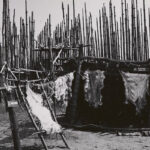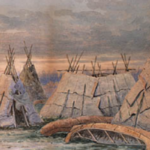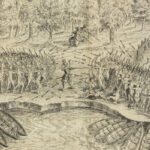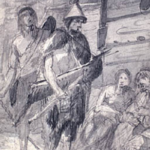Peguis First Nation: Guardians of Treaty Rights and Anishinaabe Heritage
The Peguis First Nation, Manitoba’s largest First Nation community, carries a rich legacy of leadership, resilience, and cultural continuity. Named after Chief Peguis, a respected leader who played a pivotal role in the early history of the Red River Settlement, the Peguis First Nation’s story spans centuries. From their migration to Manitoba and their pivotal role in treaty negotiations to modern efforts in self-determination, the Peguis people have consistently demonstrated resilience, adaptability, and a steadfast commitment to preserving their heritage.
Ancient Origins: Anishinaabe Migration to Manitoba
The Peguis First Nation belongs to the Anishinaabe (Ojibwe) peoples, whose ancestral territories once spanned the Great Lakes and eastern woodlands. Following the Midewiwin prophecy, which foretold a migration to a place where food grows on water (wild rice), the Anishinaabe embarked on a centuries-long journey westward. By the late 18th century, they arrived in present-day Manitoba, settling along the waterways of the Red River Valley.
The Anishinaabe were well-suited to the rich ecosystems of Manitoba, where they hunted, fished, and gathered wild rice. Their language, Anishinaabemowin, and cultural traditions reflected their deep respect for the natural world. The waterways provided sustenance and became vital corridors for trade and communication.
Anthropologist Robin Ridington, in Trail to Heaven: Knowledge and Narrative in a Northern Native Community, notes, “The Anishinaabe migration was not just a movement of people but a continuation of cultural and spiritual traditions deeply tied to the land.”
The Leadership of Chief Peguis
Chief Peguis, born in 1774 near Sault Ste. Marie, Ontario, is a central figure in the history of the Peguis First Nation. Leading his people westward, he established the settlement along the banks of the Red River. Under his guidance, the Peguis people adapted to their new environment while maintaining their cultural identity.
Chief Peguis’s legacy is particularly tied to his relationship with the Selkirk settlers, who arrived in 1812 to establish the Red River Colony. When the settlers faced starvation and harsh winters, Peguis and his people provided food, assistance, and guidance. His actions ensured the survival of the settlement, reflecting his diplomatic acumen and his commitment to fostering peaceful relations.
Historian Sarah Carter, in Lost Harvests: Prairie Indian Reserve Farmers and Government Policy, writes, “Chief Peguis exemplified the Anishinaabe values of generosity, wisdom, and leadership during a time of significant upheaval.”
Governance and Social Structure
The Peguis First Nation traditionally adhered to Anishinaabe governance systems that emphasized consensus and collective well-being. Chiefs and councils were chosen for their ability to lead with wisdom, courage, and fairness. Elders held a revered place in the community, serving as custodians of oral history and spiritual traditions.
Ceremonial gatherings, such as the Midewiwin Lodge ceremonies, reinforced cultural identity and spiritual connection. These traditions created a strong sense of unity and continuity within the Peguis community, even as they navigated the challenges of colonization.
The Treaty 1 Negotiations
The signing of Treaty 1 in 1871 was a watershed moment for the Peguis First Nation. Chief Peguis’s descendants, alongside other Indigenous leaders, entered treaty negotiations seeking to protect their traditional way of life while accommodating the realities of settler expansion. Treaty 1 guaranteed land, education, and healthcare while preserving hunting and fishing rights.
However, the treaty’s promises were often undermined by systemic inequities. In 1907, the Peguis people were forcibly relocated from their original reserve along the Red River to the Fisher River area, over 190 kilometers north of Winnipeg. This move severed their connection to traditional lands and imposed significant hardships on the community.
Historian Margaret Conrad, in A Concise History of Canada, notes, “The forced relocation of the Peguis First Nation reflects the broader colonial pattern of land dispossession and the erosion of treaty rights.”
Resilience Through Adversity
Despite the challenges of displacement, restrictive colonial policies, and the residential school system, the Peguis First Nation maintained its cultural identity and traditions. Ceremonies, storytelling, and traditional crafts continued to be practiced, often in defiance of colonial regulations. The community also adapted to new agricultural practices, leveraging their knowledge of the land to sustain their people.
The residential school system, which sought to assimilate Indigenous children, caused profound disruption. Generations of Peguis children were removed from their families, prohibited from speaking their language, and subjected to harsh conditions. The lasting effects of this system are still felt today, but the Peguis First Nation has been a leader in efforts toward healing and reconciliation.
Modern Resurgence and Treaty Advocacy
In recent decades, the Peguis First Nation has emerged as a leader in treaty advocacy, cultural revitalization, and economic development. Efforts to preserve Anishinaabemowin and restore traditional ceremonies have been central to their resurgence. Programs in education and youth mentorship ensure that future generations remain connected to their heritage.
The Peguis First Nation has also achieved significant victories in legal challenges related to treaty rights. In 2008, the community reached a $126 million settlement with the federal government for the wrongful surrender of their original reserve lands. This settlement was a landmark achievement, underscoring the Peguis people’s determination to seek justice.
Chief Glenn Hudson, a prominent leader, stated in a 2018 interview with CBC News, “The settlement represents more than compensation; it’s about recognition of our history and our rightful place on this land.”
Environmental Stewardship
The Peguis First Nation has long been a steward of the waterways and forests of their territory. Traditional ecological knowledge informs their practices in hunting, fishing, and land management. In recent years, the community has undertaken initiatives to protect water resources and combat climate change, ensuring the sustainability of their environment for future generations.
In The Resettlement of British Columbia, historian Cole Harris writes, “The Peguis people’s commitment to environmental stewardship reflects their deep respect for the interconnectedness of cultural and ecological health.”
Peguis First Nation Today
Today, the Peguis First Nation is Manitoba’s largest First Nation, with a population exceeding 10,000 members. Their thriving community blends traditional practices with modern governance and economic innovation. Initiatives in renewable energy, housing, and education underscore their commitment to sustainability and self-determination.
Annual events, such as the Peguis Treaty Days, celebrate the nation’s heritage and provide opportunities for members and visitors to engage with Anishinaabe traditions. The Peguis First Nation has also fostered partnerships with local governments, universities, and businesses, furthering their vision of reconciliation and progress.
A Legacy of Strength and Renewal
The history of the Peguis First Nation is a testament to their resilience, adaptability, and commitment to preserving their heritage. From their migration to Manitoba and their role in the establishment of the Red River Colony to their leadership in treaty advocacy and cultural revitalization, the Peguis people have upheld their identity and place within Canada’s evolving landscape.
As Chief Glenn Hudson stated, “Our story is one of strength, pride, and a commitment to honouring our ancestors while shaping a brighter future for our children and grandchildren.”
References
Ridington, Robin. Trail to Heaven: Knowledge and Narrative in a Northern Native Community. Douglas & McIntyre, 1988.
Carter, Sarah. Lost Harvests: Prairie Indian Reserve Farmers and Government Policy. McGill-Queen’s University Press, 1990.
Conrad, Margaret. A Concise History of Canada. Cambridge University Press, 2012.
Fisher, Robin. Contact and Conflict: Indian-European Relations in British Columbia. UBC Press, 1997.
Ignace, Marianne and Ronald E. Ignace. Keeping the Stories Alive: Language, Land, and Culture in Indigenous Communities. University of Toronto Press, 2008.
Harris, Cole. The Resettlement of British Columbia: Essays on Colonialism and Geographical Change. UBC Press, 1997.
Hudson, Glenn. “Reclaiming Our Legacy: The Future of Peguis.” CBC News, 2018.
Treaty 1 Elders. Voices of the Plains: Stories from Treaty 1 Communities. University of Manitoba Press, 2005.
Peguis First Nation. Guardians of the Waterways: The History and Culture of Peguis First Nation. Peguis Publications, 2015.
Trigger, Bruce G. Indigenous Peoples of Canada. McGill-Queen’s University Press, 1992.



